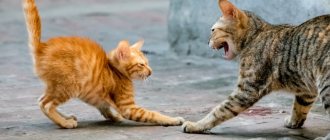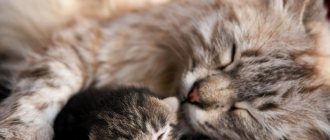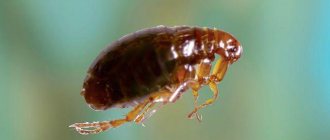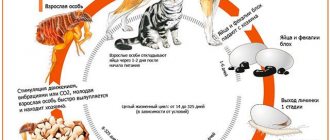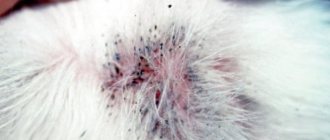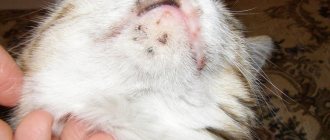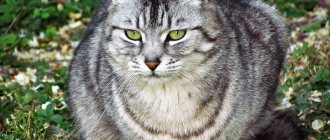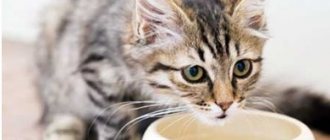Eclampsia (milk fever) is an acute disease of pregnant and lactating cats of a neurological nature, caused by hypocalcemia (decreased calcium levels in the blood), leading to convulsive seizures caused by a disorder of calcium metabolism in the body, called tetany. Tetany (from the Greek tetanos - tension, numbness, convulsion).
Calcium is a mineral that plays a vital role not only in the processes of growth, development and restoration of bone tissue, it is also necessary for the good functioning of the cardiovascular system and for regulating the functioning of the central nervous system. It is calcium that is responsible for transmitting signals to nerve endings. Hypocalcemia causes disruption of the permeability of cell membranes of neurons, which leads to disruptions in the intensity and transmission of nerve impulses, up to blockade of nervous activity and death of the animal.
During pregnancy, the body spends a large amount of labile calcium (calcium circulating in the bloodstream) to build the bodies of the fetuses, and in the last days of pregnancy also to produce milk. If there is not enough calcium circulating in the blood, the mother's body uses stable calcium, i.e. calcium contained in the bones, calcium is washed out of the bones. While feeding kittens with milk, the need for calcium increases sharply. And even if the cat continues to consume calcium in addition to food, it may still not be enough to replenish the cost of milk production. As a result, there is a decrease in calcium levels, a lack of parathyroid hormone and possible eclampsia. Most often, eclampsia develops immediately after birth, but sometimes it occurs a month or more after birth due to leaching of calcium from the cat’s body. The risk factor is the first birth, especially multiple births.
Some cats are inherently predisposed to eclampsia. If your cat is in this risk group or has already had eclampsia after a previous birth, then eclampsia is likely to recur. You should consult with your veterinarian in advance about the dosage of calcium in the diet of a pregnant cat in the second half of her pregnancy.
Many people perceive incipient eclampsia as whims on the part of the cat, and yet delay is extremely dangerous and in the presence of even weak signs it is necessary to urgently begin treatment so as not to lose both the cat and the kittens.
Nature of the disease
Eclampsia or postpartum tetany is a neurological disease that affects cats during pregnancy and lactation. The provoking factor is hypocalcemia (a decrease in blood calcium to a critical level). This trace element is critical in maintaining bone growth and density, as well as proper functioning of the nervous system. During gestation, the cat's body loses a lot of calcium to ensure the growth and development of the fetus. With breast milk, the mother also spends her reserves of this microelement in large quantities.
© shutterstock
Overactivity of the parathyroid gland most often gives impetus to the development of postpartum eclampsia. At the same time, parathyroid hormone, which is involved in the regulation of calcium levels, falls. The trace element freely circulating in the blood begins to be lacking and the body replenishes its reserves by leaching from the bones. Contraction of skeletal muscles leads to convulsive movements that resemble symptoms of strychnine poisoning or tetanus.
Eclampsia is more common in cats that have just given birth; less often, this condition appears 1 month after birth. Also, the disease can manifest itself in a cat even before delivery.
The causes of eclampsia in a cat after childbirth may be the following::
- First birth.
- Multiple pregnancy.
- Elderly age.
- Individual predisposition.
- Unbalanced diet during pregnancy.
- Diseases of the digestive system that interfere with the normal absorption of calcium.
Causes
Knowing the causes of postpartum eclampsia in cats is very important. If we talk about eclampsia in cats, it is worth mentioning that the disease occurs in pets only during the postpartum period. The push effect itself is considered a very powerful nervous disorder, which can be caused by three reasons:
- genetic predisposition - some animals are more prone to eclampsia at the gene level. They may have a weak nervous system, or the code is inherent in natural features;
- metabolism - this factor can depend both on diet and on nervous disorders that can be caused by severe stress;
- factors whose influence comes from the outside - these reasons include difficult or too frequent childbirth. Lack of nutrients, in our case calcium.
Symptoms
As calcium levels drop, the symptoms of eclampsia in cats will progress. They usually appear in this order :
- Anxiety.
- Disorientation.
- Noise phobia, even of low sounds.
- Stable dilation of the pupils without reaction to light.
- Pallor of the mucous membranes.
- Increased salivation.
- Foaming at the mouth.
- Hoarseness of voice.
- Fever.
The cat may behave unusually towards its owners and newborn kittens, and may hide in dark places.
The attack is preceded by an unsteady gait, muscle tremors, and a causeless fall. In the back of the body, sensitivity is impaired, up to temporary paralysis. The cat sticks out its tongue, breathes heavily and frequently, and the outline of its muzzle becomes sharper.
At the end of an attack of eclampsia, the animal’s entire body is seized by a spasm that is aggravated by the slightest touch. After this, the energy reserves in the muscle tissue are depleted, and the cat lies motionless for half an hour.
© shutterstock
The consequence of this condition is a drop in the concentration of glucose in the blood, which can be manifested by a change in taste preferences and increased cravings for food.
The interval between attacks is usually 1-24 hours, and during this time no signs of illness are observed. It is extremely rare that symptoms of the disease may appear before kittens are born, and this often results in the birth of dead or nonviable offspring. If on the eve of delivery a cat shows signs of eclampsia, it is necessary to resort to a caesarean section as soon as possible.
Characteristic clinical signs
The symptoms of the disease are pronounced, so it is almost impossible to miss the signs of eclampsia.
These include:
- Refusal to feed and increased salivation.
- Increased temperature and irregular heart rhythm.
- Frequent breathing and depression.
- Paleness of the conjunctiva and mucous membranes.
- Behavioral disturbance - the animal begins to worry or, on the contrary, behaves inhibited. Concern for the kittens increases, the cat hides them or moves them from one place to another. The mother can also abandon her offspring.
Severe symptoms include:
- loss of consciousness;
- presence of seizures;
- numbness of some parts of the body;
- loss of coordination.
All these signs of milk fever are increasing. And you need to be able to notice them in time and take the necessary measures.
Diagnosis of eclampsia
If you notice symptoms of eclampsia in a cat that has recently given birth, you should immediately show it to a doctor and begin treatment. An increase in body temperature to 41° can lead to the death of the animal within 12 hours.
Diagnosing postpartum eclampsia is not difficult; the main thing is to inform the veterinarian that the cat has recently given birth. To confirm the diagnosis, the doctor may take blood from the cat for general and biochemical indicators. If calcium levels drop to 18 mmol/L or below, postpartum eclampsia is present. A decrease in magnesium and glucose levels in the blood, along with an increase in potassium levels, is also an indicator of the disease.
Prevention of eclampsia in cats
Better than any treatment is the absence of disease. Preventive measures will help prevent the onset of illness in your pet. They consist of certain actions aimed at improving the health of the animal and its conditions of detention. All recommendations are created by leading veterinarians. In the case of eclampsia, strong attention needs to be paid to the cat during pregnancy. Below are some of them:
- nutrition - when an animal carries offspring in its tummy, it should be remembered that it shares all the nutrients it receives with the future kittens. That is why it is necessary to fully saturate the body with all the necessary microelements;
- emotional state – during pregnancy you should avoid various stresses that can have a detrimental effect on both the health of the fetus and the health of the cat itself;
- Other diseases - diseases suffered by animals during pregnancy will in any case leave a mark on the general condition.
Treatment
Ignoring the disease can threaten the health and life of the animal. You cannot try to normalize your pet’s condition by giving her calcium tablets, since at this stage it is no longer effective.
Treatment includes:
- Administration of 10% calcium gluconate by intramuscular injection. The medicine must first be heated to 40°C and diluted with saline solution. This will help prevent necrosis and reduce pain. The drug should be administered once every 40-50 minutes until the symptoms disappear. In this case, the dose should be calculated so that it does not exceed 10 ml per day.
- During the period of exacerbation, treatment of eclampsia should be supplemented with subcutaneous administration of magnesium sulfate. It is not recommended to place calcium gluconate and magnesium sulfate injections in the same paw.
- To strengthen the weakened body, the cat is given a glucose solution and medications that stabilize the heart.
- To maintain the therapeutic effect, calcium gluconate must be continued for another 2-7 days. This will help reduce the frequency of attacks of postpartum eclampsia in cats.
- You can also influence the disease with the help of homeopathy (Lachesis Compositum in injections or drops).
- Herbal medicines, such as Kot Bayun, are also used in the treatment of eclampsia.
Eclampsia in a pet after birth should be treated under the supervision of a veterinarian. The cat needs weekly monitoring of calcium levels in the blood. You can stop therapeutic measures only with the agreement of a specialist. The cat should be regularly monitored by a veterinarian throughout the breastfeeding period.
A cat suffering from postpartum eclampsia needs to be kept quiet and away from irritants such as bright lighting.
If the cat's health worsens, it is necessary to remove the kittens from her for at least a day. All this time, newborns must be bottle-fed. Skim milk or milk formulas are suitable for this purpose. If the offspring is already grown up, there is no need to switch them back to breastfeeding. This will help preserve the mother's calcium reserves and alleviate her condition.
© shutterstock
In some cases, your veterinarian may recommend that your cat undergo the entire course of treatment in a clinic, especially if she will be receiving medications intravenously.
Risk group
Cats of different ages and genders can be susceptible to the disease.
Animals at risk include:
- primiparous;
- with multiple pregnancy;
- having calcium deficiency during previous births;
- those receiving an unbalanced diet or medications that reduce calcium levels in the blood;
- aged.
First aid for seizures
Seizures in a cat are a serious sign of pathology. Any pet owner should be prepared for the appearance of such a symptom, and should also know what to do to alleviate the pet’s condition.
First of all, you need to take the cat to the flattest surface in the house, covering it with an unnecessary rag or a disposable diaper. It is worth remembering that it is not recommended to forcibly hold the animal, and also try to unclench the clenched jaws.
Do not give medications to relieve pain and cramps through the oral cavity. This is due to the fact that during an attack, certain muscle groups in a cat contract and the animal may simply choke on the medications.
You can try giving your pet a light massage in the place where uncontrolled muscle contraction was observed. The occurrence of even one seizure attack is a reason to consult a veterinarian. You shouldn’t let the situation take its course and wait for the next attack.
Which cats are at risk?
Pathology can be observed in both outbred and purebred cats. First of all, the development of eclampsia is influenced by external factors (poor nutrition, multiple pregnancy). But there is a predisposition to calcium deficiency. For example, if a cat developed this pathology during her previous pregnancy, then most likely the situation will repeat itself when carrying kittens again.
A cat carrying or nursing more than 5 kittens is at particular risk of developing eclampsia
Cats with the parathyroid glands removed, those exposed to radioactive substances, or survivors of severe chemical poisoning are at risk of eclampsia. According to statistics, cats that become pregnant over the age of 6 years are susceptible to intense calcium leaching, which is explained by an age-related slowdown in metabolic processes.
Often, a violation of the absorption of minerals occurs as a complication after poisoning - as a result of the activity of toxins that bind to calcium molecules and prevent the body from absorbing them
Prognosis for recovery
If treatment is started in the mild or moderate stage of eclampsia, then the animal can always be saved, and the risk of complications is minimal. As a rule, after 7–10 days the animal recovers completely. When it comes to a severe form (develops 10–12 hours from the onset of the attack), the chances of saving the animal are small due to the onset of cerebral edema and depression of respiratory function. If in this condition the cat has not yet given birth, then the situation is complicated by the consequences of surgical delivery.
Eclampsia is deadly, so you need to take a pregnant or postpartum cat to the doctor if there are any alarming symptoms, be it dilated pupils or increased nervousness of the animal
